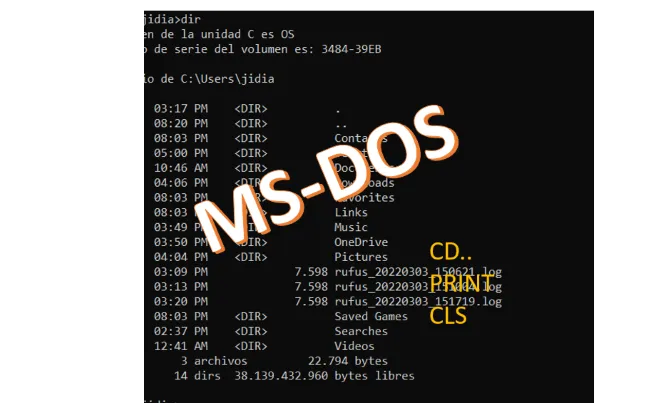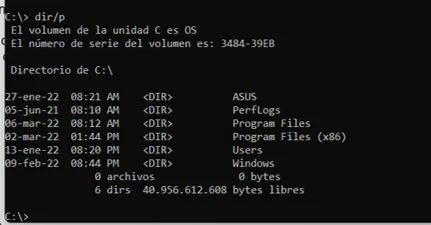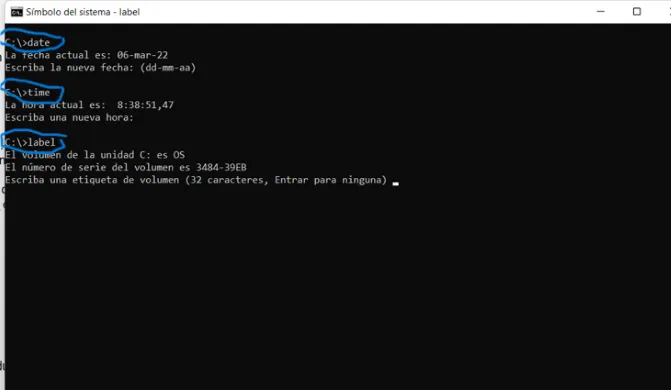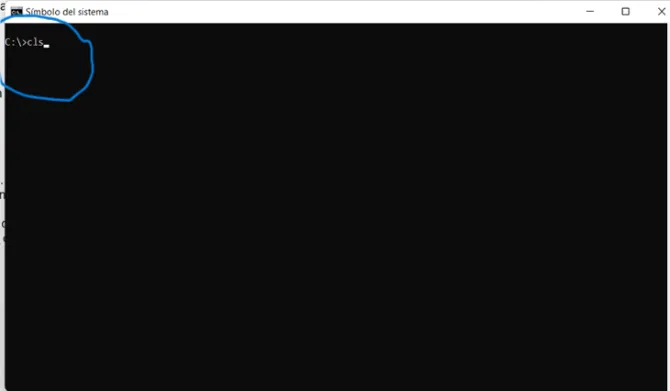MS-DOS Microsoft Disk Operating System / Sistema operativo de disco de Microsoft
Hello friends, I hope you are all very well. I welcome you to my blog. On this occasion I would like to share a brief overview of MS-DOS and some of its commands.
Hola amigos, espero que todos estén muy bien. Les doy la bienvenida a mi blog. En esta ocasión me gustaría compartirles una breve reseña sobre el MS-DOS y algunos de sus comandos.


The MS-DOS program is a program created by the Microsoft company, its acronym means: Microsoft Disk Operating System. MS-DOS was created for IBM computers and their compatible ones, in order to control the hardware and software of a computer or computer.
It allows the use of the applications that are inside the computer, creates and maintains the files, facilitates the use of the peripheral units and allows to coordinate the good functioning of the computer with the application software.
It is used through the use of instructions called commands, which are used to manage files, control workflow and perform useful tasks.

El programa MS-DOS, es un programa creado por la empresa Microsoft, sus siglas significan: Sistema operativo de disco de Microsoft. El MS-DOS fue creado para computadores IBM y sus compatibles, con la finalidad de controlar el hardware y el software de un ordenador o computadora.
Permite el uso de las aplicaciones que se encuentran dentro del computador, crea y mantiene los archivos, facilita el uso de las unidades periféricas y permite coordinar el buen funcionamiento de la computadora con los software de aplicación.
Se emplea mediante el uso de instrucciones llamadas comandos, los cuáles sirven para manejar los archivos, controlan el flujo de trabajo y desarrollan tareas útiles.
The files are classified in:
- Text files, are those that contain the information we can see and are generated by word processors.
- Data files, are those that store the information that is only read by a program,
- Program Files, they are the programs that can be executed, being their extensions .COM and .EXE.
Los archivos se clasifican en:
- Archivos de Texto, son los que contienen la información podemos ver y los generan los procesadores de texto.
- Archivos de Datos, son los que guardan la información que solo es leída por un programa,
- Archivos de Programas, son los programas que se pueden ejecutar, siendo sus extensiones .COM y .EXE

To access these commands, in Windows look for the command prompt and type MSD and ENTER. New window will open and from there you will be able to use these commands and manage files on your computer.
INTERNAL COMMANDS
There are internal and external commands, the internal commands are those that are transferred to memory, when the operating system is loaded, they can be executed without the need to have DOS present in the unit by default from which you can run the command and these are stored in a file called COMMAND.COM.
Para acceder a estos comandos, en Windows se busca el simbolo del sistema, y teclea MSD Y ENTER. Se abrirá una nueva ventana y desde allí podrás utilizar dichos comandos y manejar los archivos de tu compu.
COMANDOS INTERNOS
Existen comandos internos y externos, los comandos Internos, son los que se transfieren a la memoria, el momento de cargarse el Sistema Operativo, permiten ejecutarse sin necesidad de tener el DOS presente en la unidad por defecto desde el cual se puede ejecutar el mandato y estos se encuentran almacenados en un archivo llamado COMMAND.COM.
- CLS: clears the screen
- CD: Change sub directories
- COPY allows you to make copies of files on floppy disks.
- DATE: gives the date of the operating system.
- DIR: allows you to see all the files contained in a subdirectory.
- The command can be: dir/p (per page) or Dir/w (per block).
- ERASE: delete files
- PATH: change the path from one subdirectory to another.
- RENAME renombra archivos
- TIME da la hora del sistema operativo.
- MD: crea subdirectorios
- RD: delete subdirectories
- CLS limpia la pantalla
- CD: Cambiar sub directorios
- COPY permite realizar copias de archivos en los diskettes.
- DATE: da la fecha del sistema operativo.
- DIR: permite ver todos los archivos contenidos en un subdirectorio.
- El mandato puede ser: dir/p (por página) o Dir/w (por bloque)
- ERASE: borra archivos
- PATH cambiar la ruta de un subdirectorio a otro
- RENAME renombra archivos
- TIME da la hora del sistema operativo.
- MD: crea subdirectorios
- RD: borra subdirectorios

EXTERNAL COMMANDS
They are stored in command files called transient or external, and in order to be executed they need them, they have their own name and allow copying information from one disk to another.
AMONG THEM WE HAVE
BACKUP: makes backup copies of files.
FORMAT: used to initialize blank diskettes and erase unusable information on the diskettes.
RESTORE: restores backup copies of files.
PRINT: allows you to print a file.
LABEL: allows you to label the hard disk.
COMANDOS EXTERNOS
Se almacenan en archivos de comandos denominados transitorios o externos, y para poder ejecutarse necesitan de ellos, tienen nombre propio y permiten copiar información de un disco a otro.
ENTRE ELLOS TENEMOS
BACKUP: hace copias de respaldo de archivos.
FORMAT: con se inicializaban los diskettes vírgenes y se borraba información no utilizable en los diskettes.
RESTORE: restaura copias de respaldo de archivos.
PRINT: permite imprimir un archivo.
LABEL: permite etiquetar el disco duro.



Thank you very much for visiting my blog @jidianmar. I send you many blessings, have a great day, take care and have a good time.
Queridos amigos, espero que les haya gustado esta breve reseña sobre el sistema operativo DOS y algunos de sus comandos.
Muchas gracias por visitar mi blog @jidianmar. Les envió muchas bendiciones, que tengan un excelente día, cuídense y pásenla bien.

Photos edited with Canva
Photos edited with Canva and screenshots of my computer azus vivo
Photos of my authorship Copyright reserved
Translated with www.DeepL.com/Translator (free version)
Fotos editadas con Canva y capturas de pantalla de mi computadora azus vivo
Fotos de mi autoría Derechos de autor reservados
Traducido con www.DeepL.com/Translator (versión gratuita)

